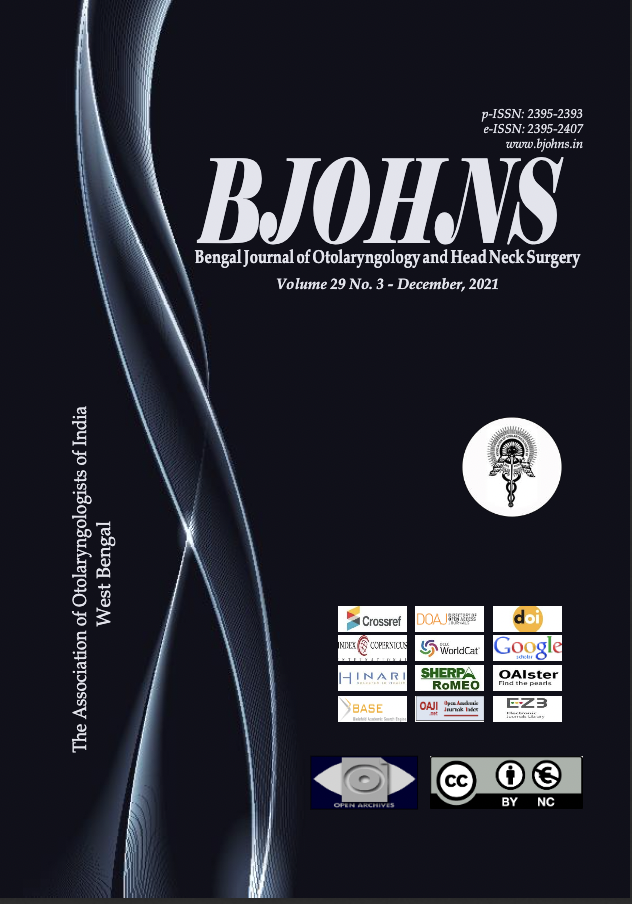Changing Trends in Tracheostomy in a Critical Care Unit: A Study from a Tertiary Care Centre in Western India
Main Article Content
Abstract
Introduction
Identification of newer trends in indications and timing of tracheostomy and their implication on the outcome of the patients in a critical care unit, based on observations recorded in patients from a tertiary care centre in Western India.
Materials and Methods
100 patients admitted in the critical care unit, who underwent tracheostomy, were studied retrospectively. The patients were analyzed for the epidemiological data, indications, timing, and outcome of the tracheostomy. The outcomes were assessed based on mortality, discharge, decannulation, complications and VAP as parameters. A comparative analysis of the outcome of the tracheostomy depending on the timing of tracheostomy was conducted.
Results
Male: Female ratio was 1.77:1. Majority of the patients belonged to the age group of 21 to 40 years. Anticipation of prolonged airway was commonest indication for tracheostomy (49%). Early tracheostomy was preferred (68%). The mortality rate was 38%. 48% of patients were discharged with a successful decannulation in 72.9% of them. Complications and VAP were observed in 16% and 23% of patients, respectively. The timing of tracheostomy had a significant impact on the outcome.
Conclusion
Anticipating prolonged intubation is the most important indication for tracheostomy in the critical care unit. Early tracheostomy is associated with favourable outcomes in terms of decreased mortality, improved survival rate, lesser complication, low incidence of VAP, and thus, better weaning. As soon as the need for prolonged management of the airway is identified, tracheostomy should be considered.
Article Details

This work is licensed under a Creative Commons Attribution-NonCommercial 4.0 International License.
References
Olszewski J, Miłoński J. Historia tracheotomii. Otolaryngologia Polska 2007; 61(3):349-52
Pracy P. Tracheostomy. In: Gleeson M, Browning G, Burton M et al., eds. Scott Brown’s Otolaryngology and Head-Neck Surgery. 7th ed. London, Hodder Arnold; 2008:2292-304
Durbin C. Tracheostomy: Why, When, and How?.Respiratory care 2010; 55(8):1056-68
El-Anwar M, Shawadfy M, Maaty A, Khazbak A, Nofal A. Tracheostomy in the Intensive Care Unit: a University Hospital in a Developing Country Study. International Archives of Otorhinolaryngology 2016; 21(01):33-7
Chandrashekar Y, Viswanatha B, Srinivasan S, Jayaram R, Vijayashree M. Tracheostomy in Intensive Care Unit: Indications and Outcomes at a Teaching Hospital. Research in Otolaryngology 2016; 5(2):28-31
Cheung N, Napolitano L. Tracheostomy: Epidemiology, Indications, Timing, Technique, and Outcomes. Respiratory Care 2014; 59(6):895-915
Mahmud M, Hossain M, Sarkar M, Hossain H, Islam M, Ahmed M, et al. Tracheostomy in Intensive Care Unit: Indications, Benefits and Complications. Bangladesh Journal of Otorhinolaryngology 2015; 21(1):28-32
McClelland R. Complications of tracheostomy. BMJ 1965; 2(5461):567-9
Itamoto C, Lima B, Sato J, Fujita R. Indications and Complications of Tracheostomy in Children. Brazilian Journal of otorhinolaryngology 2010; 76(3):326-31
Flaatten H, Gjerde S, Heimdal J, Aardal S. The effect of tracheostomy on outcome in intensive care unit patients. Acta Anaesthesiologica Scandinavica 2005; 50(1):92-8
Adedeji T, Idowu J, Olaosun A, Tobih J. Indications and outcomes of tracheostomy: An experience in a resource-limited environment. Journal of Health Research and Reviews 2014; 1(2):40
Durbin C. Indications for and Timing of Tracheostomy. Respiratory care 2005; 50(4):483-7
Colice G. Resolution of Laryngeal Injury Following Translaryngeal Intubation. American Review of Respiratory Disease 1992; 145(2_pt_1):361-4
Trottier S, Hazard P, Sakabu S, Levine J, Troop B, Thompson J, Mc Nary R. Posterior Tracheal Wall Perforation During Percutaneous Dilational Tracheostomy. Chest 1999; 115(5):1383-9
Nair G, Niederman M. Ventilator-associated pneumonia: present understanding and ongoing debates. Intensive Care Medicine 2014; 41(1):34-48
Yildirim F, Tahir E. Relationship between Tracheostomy and Ventilator-associated Pneumonia in Intensive Care. Turkish Journal of Medical and Surgical Intensive Care 2017; 8(1):19-24
Rumbak M, Newton M, Truncale T, Schwartz S, Adams J, Hazard P. A prospective, randomized, study comparing early percutaneous dilational tracheotomy to prolonged translaryngeal intubation (delayed tracheotomy) in critically ill medical patients. Critical Care Medicine 2004; 32(8):1689-94
Diaz-Prieto A, Mateu A, Gorriz M, Ortiga B, Truchero C, Sampietro N, et al. A randomized clinical trial for the timing of tracheotomy in critically ill patients: factors precluding inclusion in a single center study. Critical Care 2014;18(5):585
Mohamed K, Mousa A, ElSawy A, Saleem A. Early versus late percutaneous tracheostomy in critically ill adult mechanically ventilated patients. Egyptian Journal of Chest Diseases and Tuberculosis 2014; 63(2):443-8
Zheng Y, Sui F, Chen X. Early versus late percutaneous dilational tracheostomy in critically ill patients anticipated requiring prolonged mechanical ventilation. Chin Med J. 2012; 125:1925-30
Trouillet J, Luyt C, Guiguet M, Ouattara A, Vaissier E, Makri R, et al. Early Percutaneous Tracheotomy Versus Prolonged Intubation of Mechanically Ventilated Patients After Cardiac Surgery. Annals of Internal Medicine 2011; 154(6):373-83
Blot F, Similowski T, Trouillet J, Chardon P, Korach J, Costa M, Journois D, et al. Early tracheotomy versus prolonged endotracheal intubation in unselected severely ill ICU patients. Intensive Care Medicine 2008; 34(10):1779-87.

